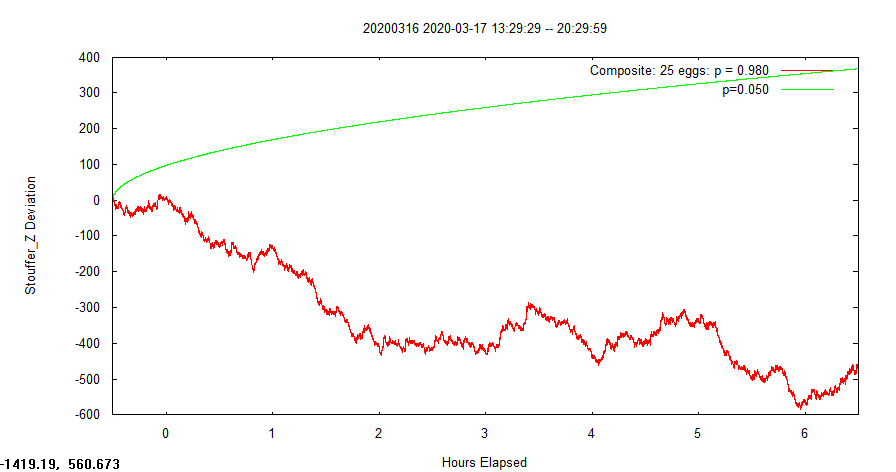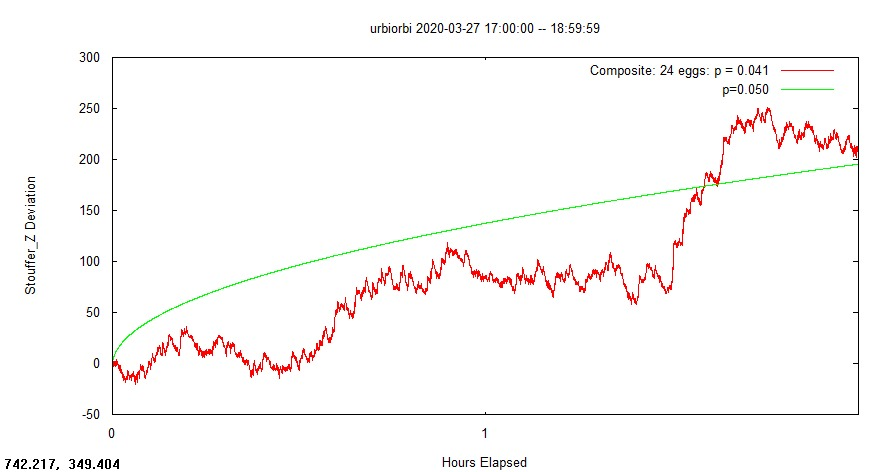Starting in late February, 2020, the news in US media has been filled with concerns about the novel Coronavirus first identified in Wuhan, China. In the US at that time, there were reports on the disruptions overseas and warnings that there would be a worldwide spread of the Covid-19 virus. Since then, we have recognized this is a pandemic that will likely infect a large proportion of the world population. In connection with the physical spread of the virus, there is another “viral” effect – on the world’s economies – with serious and continuing disruptions. This can be seen in stock market activity which has fluctuated wildly over the last few weeks, with extreme daily changes of 5-13%.
The Global Consciousness Project (GCP) is a long-term experiment designed to capture evidence of a possible unconscious interconnection of large numbers of people experiencing similar emotions. The GCP instrument is a network of continuously running random number generators (RNG) with nodes at up to 70 locations around the world. Each node generates a 200-bit trial each second (like flipping 200 coins and counting the heads) and sends the data to a central archive for later analysis. We predict that when events drive people to shared experience and engagement, there will be changes in the data from our network. The hypothesis is that normally random output from the widely-separated RNG devices will show structure during “global events”. When a mass consciousness forms in response to a major event, we predict correlations among the widely separated RNGs. Formal tests specify the time of a global event (e.g., a terrible accident, an earthquake, a terrorist attack) followed by a few hours for the global response to develop as news of the event spreads. We also track events which are less sharply focused, but still engage millions, for example Earth Day, or the Kumbh Mela celebration when tens of millions gather to bathe away their sins in the Ganges in northern India.
The GCP instrument – the worldwide network of RNGs – is designed for focused events of a few hours duration, and can’t readily be applied to long-lasting turmoil such as the slowly developing Covid 19 pandemic. However, while we can’t answer specific questions about the pandemic, we were curious about the possible effect and decided to do some sampling to see whether the network might be responding. We looked at the seven-hour long period when the US stock market is open on five days beginning with March 11, 2020. Although the results cannot be interpreted rigorously and should not be taken as evidence for reliable scientific conclusions, they are interesting, to say the least.
The probes for March 11-13, 16, and 17 showed strong departures on four of the days, one upward and three downward. The fifth case showed typical random variation. This is an informal assessment, but it is meaningful that four of the five samples show strong departures from expectation: the network was not producing normal random data during this time. Thus, although we can’t do rigorous testing, this looks like the GCP network is reacting to the intense and emotionally powerful Coronavirus crisis that has captured our attention all around the world.
Graphical displays of the data can help illustrate why we draw this conclusion. In these graphs, the jagged line shows the accumulating deviation of scores over the sample period. Such a trace, if nothing is going on, should be level, but instead we see a clear trend that persists over the test period. Figure 1 below shows the data from March 17. The odds against chance for the accumulated deviation are about 50 to 1. Three of the four other samples have similar odds. Only one looks normal.
GCP Network Variance on 17th Mar 2020, 09:30 to 16:30 EST

I assessed one other event related to the Coronavirus crisis. It was not a sample of the ongoing turmoil, but a single, sharply focused event. Pope Francis made a special Urbi et Orbi, on Friday, March 27th at 6:00 pm, praying for relief from the suffering brought by the Coronavirus so tragically affecting Italy and the rest of the world. I extracted and processed the corresponding data (two hours beginning at 18:00 CET). Figure 2 shows the result, a consistent departure from random expectation that supports the GCP’s general hypothesis.
GCP Network Variance on 27th Mar 2020, 16:00 to 18:00 CET

The results we see in the data collected during the Coronavirus crisis are certainly suggestive. These are not rigorously controlled experiments, but the results are similar to those in the GCP formal series. It is unlikely that the trends in these samples are merely chance variation, so although the results aren’t proof of a relationship, our responses to news about the health crisis or market fluctuations may be reflected in the patterns in our data. These informal probes, like the formal data, are suggestive evidence of our deep interconnections. They make visible the unconscious links that bind us, and encourage us to bring those connections into our conscious awareness.
For more information on this Global Consciousness Project experiment, download the report.
About the Author
 Roger Nelson, PhD, is Director of the Global Consciousness Project (GCP). He created the GCP in 1997, building a world-spanning random number generator network designed to gather evidence of coalescing global consciousness. His focus is on mental interactions, anomalous information transfer, and effects on physical systems by individuals and groups. Roger is a Fellow of the Institute of Noetic Sciences. He is the author of Connected: the Emergence of Global Consciousness and Der Welt-Geist: wie wir alle miteinander verbunden sind with Georg Kindel.
Roger Nelson, PhD, is Director of the Global Consciousness Project (GCP). He created the GCP in 1997, building a world-spanning random number generator network designed to gather evidence of coalescing global consciousness. His focus is on mental interactions, anomalous information transfer, and effects on physical systems by individuals and groups. Roger is a Fellow of the Institute of Noetic Sciences. He is the author of Connected: the Emergence of Global Consciousness and Der Welt-Geist: wie wir alle miteinander verbunden sind with Georg Kindel.
